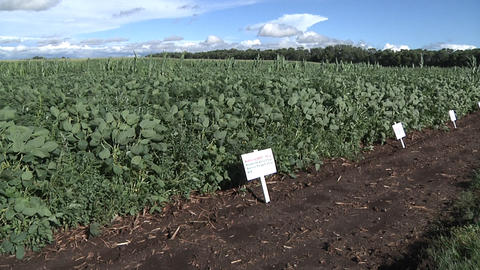VOLGA, S.D. — The summer tour at South Dakota State University’s Volga Research Farm focused on weed resistance and weed control systems, as well as cover crop management.
Researchers displayed the newest technology they’re testing in biotech weed control systems like HT3 soybeans, which are tolerant to glyphosate, Liberty and dicamba herbicides. “By new technologies I mean in the seed area,” says Paul Johnson, SDSU Extension weed management coordinator “We’re really not dealing with much new chemistry.”
Johnson says that’s because the companies are not making the investment, due to the time of development and the cost and short life of a patent. “We’re looking at crops that are tolerant to older chemistries as the only way we’re getting new options in that crop. It’s working well and doesn’t add a lot of cost to the producer. The farmer is going to pay a little bit more for the seed, but hopefully his chemical option is going to be cheaper,” he says.
The SDSU plots featured various weed control trials, with many targeting resistant weeds, like water hemp, kochia and mares tail, that are resistant to the herbicide glyphosate or Roundup. “With glyphosate we’re running a good 50 percent resistant and consequently that helps us evaluate those treatments,” Johnson says.
Researchers are looking at these systems because control of resistant weeds has become very costly. Johnson says when farmers relied on glyphosate they used to spend $5 to $10 per acre annually on their weed programs. “Now we’re talking a lot of treatments $40 to $50 an acre a year, with the pre-emergent down and following with post emergence programs,” he says. However, if farmers don’t control these weeds, they lose yield, especially in soybeans. “The alternative of not putting our pre-emergent herbicides down and trying to do just a post-emergent can get a lot costlier. It’s not necessarily in the chemical cost, but reduced yields because they’ve got a weed problem that they didn’t get under control,” Johnson adds.
Johnson advises producers to prevent weed resistance on their farms by switching up programs and herbicides or classes of chemistry. “Use different modes of action between your soybeans and your corn. We want to continue rotating so in the future we don’t have more resistant problems,” he says.
The management approach each farmer takes is dependent on his weed problems. As a result, Johnson says they run the same treatments at three locations in the state, including the Volga farm, and look at a wide variety of weeds. This way they can help farmers use the approach that is best for their area. “When you go through our data we can select those ones that work best for each weed.”
Johnson says they aren’t doing any weed trials yet on Palmer amaranth. It has been reported in nearly 20 sites in South Dakota and is a concern. He says it’s being introduced in various ways. “It’s moving in mostly on equipment and seed, and livestock trailers can haul it in the manure,” he says.
Anthony Bly, SDSU Extension soils field specialist, also talked about cover crops. “Management of cover crops is an art and you have to understand the species that you’re planting and the purpose that you’re planting them for,” he says.
Bly showed farmers a study he’s conducting on the specific relationship between various cover crops and soil carbon and nitrogen. He says the nitrogen and carbon ratios vary in different cover crops. “For example, cereal rye has a higher carbon-to-nitrogen ratio, meaning there’s less nitrogen per unit of carbon that’s out there,” he says. “Clover has a narrow ratio, meaning that it has more nitrogen per unit of carbon.”
So, Bly says farmers want to choose the higher carbon and nitrogen ratio or they can end up with very little residue in the field. “If you have a low residue crop to begin with and you come back and plant another crop or a legume crop that has a narrow carbon and nitrogen ratio, your residue can disappear faster than you want it to and so managing carbon is what it’s all about,” he says.
According to Bly, the cover crop that works best depends on the location and the purpose of the cover crop. However, the main benefit is still soil health. “It provides a great avenue for cycling nutrients and keeping the nutrients in the ecosystem,” he says.
It also keeps the ground less vulnerable to heavy rain events. Weed control is an added advantage. “Some producers are looking at rye for weed suppression and you see that in any cereal grain field though. Cover crops are good at suppression and we see that in these plots here,” he says.
The tour also provided updates on crop and insect management, crop performance testing and new weather tools.
Credit:www.agweek.com




